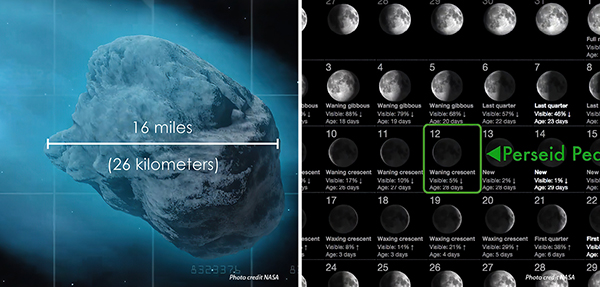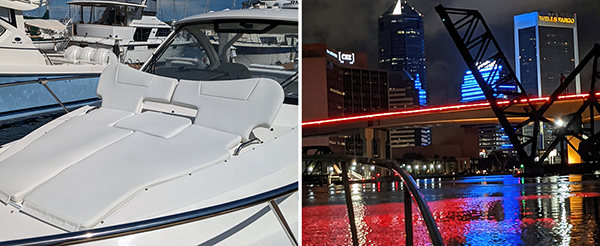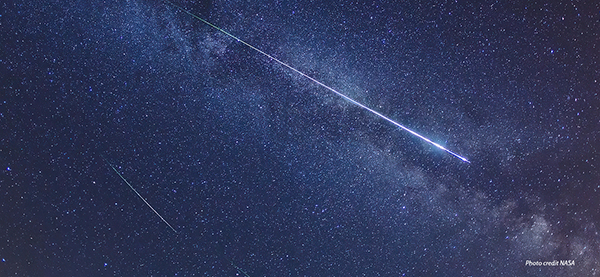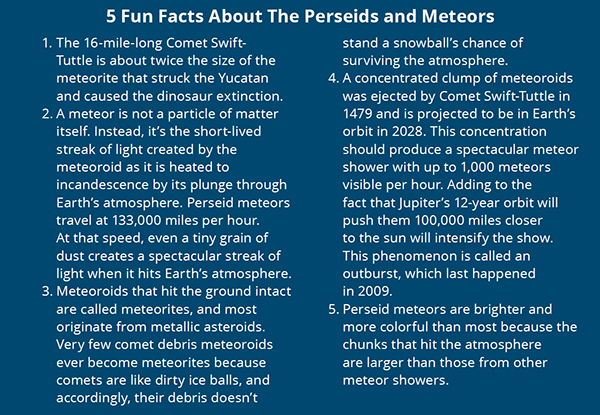The Perseid meteor shower is one of nature’s most spectacular annual fireworks displays. Seeing them on a boat creates an unforgettable memory.
What are The Perseids?
Every year in August, the Earth plows through an icy, rocky debris field shed by the Comet Swift-Tuttle, the largest object that makes repeated passes near our planet. This comet has been traveling for billions of years and has been observed by astronomers since 188 AD. When these castoff pieces of comet enter Earth’s atmosphere, the air in front of them is compressed, which heats up and raises the temperature of the debris to more than 3,000 degrees Fahrenheit. The intense heat usually vaporizes the material, which is called a meteor, but if it reaches Earth’s surface, it becomes a meteorite.
The term meteor shower comes from the fact that if you track meteors backward on the sky’s dome, you’ll find them streaming from their radiant, which is a single point within the backdrop of a constellation. The Perseids are so named because their radiant lines up with the constellation Perseus, 250 light years away from the debris field itself. During peak viewing in 2024, watchers can expect to see up to 100 shooting stars an hour.

When to See the Perseids
This is a prime year to see the Perseids, and their peak should occur from August 11 to 13. Moonlight is the enemy of nighttime meteor viewing, and this year, the illumination from the moon will be at about 50 percent, and it sets just after midnight, which is true for all American time zones. There are two strategies: stay up late or wake up early. The peak of the shower comes at 14 UTC (universal time coordinated), which is 9:00 a.m. EST.
That makes the best viewing time closer to morning than midnight. It takes about 45 minutes for eyes to be acclimated, so a start time around 3 in the morning will give meteor hunters an hour or two of viewing time. Kids can always take catnaps to stay fresh, and you can wake them up if a flurry of meteors is spotted. If you can’t do it on August 12, the days just before and after also have good viewing.
Getting Ready to Watch Meteors
Check the weather forecast to ensure there’s no approaching storm because of the danger and the fact you can’t see meteors if there are clouds. Nighttime can get cool, so dress accordingly. Remember, lifejackets like those used for watersports are warm and can serve two purposes. If mosquitos might be present, take along a Thermacell, which heats a small blue wafer that contains a chrysanthemum-based repellent.

Having a boat already in the water will allow your party to shove off quickly and simplifies the process. Since most of the action is overhead, use bowrider seats or sunning pads to gaze at the stars comfortably, otherwise, you’ll end up with a crick in your neck. If you have available deck space, bring along inflatable rafts and lay on them.
Bring snacks and beverages to add to the party atmosphere.
Those not driving the boat or keeping watch can close their eyes to increase
night vision.
When in position, don’t worry about concentrating on the radiant; just let your eyes relax and try to take in as much of the sky’s dome overhead as possible and be alert for movement.

Where to Go in Your Boat
Like moonlight, light pollution from cities is another problem for those trying to see a meteor shower, so the goal is to get as far away from civilization as is practical. Because you’ll be cruising after the moon has set, skippers must rely on their GPS to navigate, so choosing a familiar route is preferable. To preserve night vision, turn down the intensity of the screen. The same goes for your cell phone; keep it in your pocket or turn the screen’s intensity below 15 percent. Unless your boat is equipped with a night vision camera, cruising no faster than at a fast idle is a prudent precaution.
If you choose to anchor or drift, turn off the running lights and illuminate the anchor light. Another option is to find a sandy shoreline and beach the boat. The advantage of this is the anchor light can be turned off to add to the darkness. And a boat that isn’t rocking will also be a plus if taking photos. If any light pollution is still visible, find a tree-covered shoreline to block out the light.
Night time excursions on a boat are always fun, but having an event to watch, like observing the Perseid meteor showers, makes it even more special.

Back to Blue Life
What are The Perseids?
Every year in August, the Earth plows through an icy, rocky debris field shed by the Comet Swift-Tuttle, the largest object that makes repeated passes near our planet. This comet has been traveling for billions of years and has been observed by astronomers since 188 AD. When these castoff pieces of comet enter Earth’s atmosphere, the air in front of them is compressed, which heats up and raises the temperature of the debris to more than 3,000 degrees Fahrenheit. The intense heat usually vaporizes the material, which is called a meteor, but if it reaches Earth’s surface, it becomes a meteorite.
The term meteor shower comes from the fact that if you track meteors backward on the sky’s dome, you’ll find them streaming from their radiant, which is a single point within the backdrop of a constellation. The Perseids are so named because their radiant lines up with the constellation Perseus, 250 light years away from the debris field itself. During peak viewing in 2024, watchers can expect to see up to 100 shooting stars an hour.

When to See the Perseids
This is a prime year to see the Perseids, and their peak should occur from August 11 to 13. Moonlight is the enemy of nighttime meteor viewing, and this year, the illumination from the moon will be at about 50 percent, and it sets just after midnight, which is true for all American time zones. There are two strategies: stay up late or wake up early. The peak of the shower comes at 14 UTC (universal time coordinated), which is 9:00 a.m. EST.
That makes the best viewing time closer to morning than midnight. It takes about 45 minutes for eyes to be acclimated, so a start time around 3 in the morning will give meteor hunters an hour or two of viewing time. Kids can always take catnaps to stay fresh, and you can wake them up if a flurry of meteors is spotted. If you can’t do it on August 12, the days just before and after also have good viewing.
Getting Ready to Watch Meteors
Check the weather forecast to ensure there’s no approaching storm because of the danger and the fact you can’t see meteors if there are clouds. Nighttime can get cool, so dress accordingly. Remember, lifejackets like those used for watersports are warm and can serve two purposes. If mosquitos might be present, take along a Thermacell, which heats a small blue wafer that contains a chrysanthemum-based repellent.

Having a boat already in the water will allow your party to shove off quickly and simplifies the process. Since most of the action is overhead, use bowrider seats or sunning pads to gaze at the stars comfortably, otherwise, you’ll end up with a crick in your neck. If you have available deck space, bring along inflatable rafts and lay on them.
Bring snacks and beverages to add to the party atmosphere.
Those not driving the boat or keeping watch can close their eyes to increase
night vision.
When in position, don’t worry about concentrating on the radiant; just let your eyes relax and try to take in as much of the sky’s dome overhead as possible and be alert for movement.

Where to Go in Your Boat
Like moonlight, light pollution from cities is another problem for those trying to see a meteor shower, so the goal is to get as far away from civilization as is practical. Because you’ll be cruising after the moon has set, skippers must rely on their GPS to navigate, so choosing a familiar route is preferable. To preserve night vision, turn down the intensity of the screen. The same goes for your cell phone; keep it in your pocket or turn the screen’s intensity below 15 percent. Unless your boat is equipped with a night vision camera, cruising no faster than at a fast idle is a prudent precaution.
If you choose to anchor or drift, turn off the running lights and illuminate the anchor light. Another option is to find a sandy shoreline and beach the boat. The advantage of this is the anchor light can be turned off to add to the darkness. And a boat that isn’t rocking will also be a plus if taking photos. If any light pollution is still visible, find a tree-covered shoreline to block out the light.
Night time excursions on a boat are always fun, but having an event to watch, like observing the Perseid meteor showers, makes it even more special.

